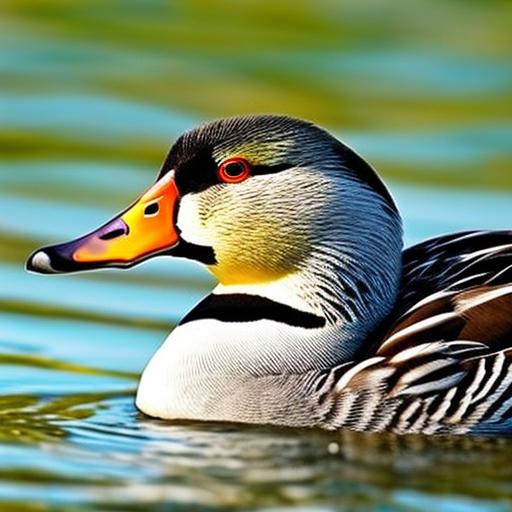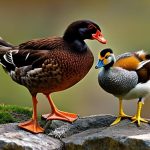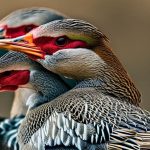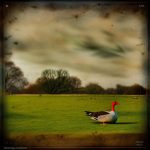Ducks and geese are both waterfowl that are often found in the same habitats, and they share many similarities in terms of their physical appearance and behavior. However, there are certain duck breeds that closely resemble geese in terms of their size, shape, and coloration. These duck breeds are often mistaken for geese at first glance, and it is important for waterfowl enthusiasts to be able to recognize and differentiate between these similar species. In this article, we will explore several duck breeds that bear a striking resemblance to geese, and we will discuss the physical and behavioral characteristics that set them apart from their larger counterparts.
The Pomeranian Duck
The Pomeranian duck is a breed that closely resembles a goose in terms of its size and shape. This breed originated in Germany and is known for its distinctive appearance, with a broad, rounded body and a long, graceful neck. The Pomeranian duck is also known for its striking coloration, which includes a combination of white, black, and gray feathers. These ducks are often mistaken for geese due to their large size and regal bearing, but they are indeed a distinct breed of duck. Pomeranian ducks are known for their calm and friendly demeanor, and they are often kept as pets or ornamental birds. They are also good layers and can produce a decent amount of eggs, making them a popular choice for small-scale egg production.
The Swedish Blue Duck
The Swedish Blue duck is another breed that closely resembles a goose in terms of its size and shape. This breed originated in Sweden and is known for its elegant appearance, with a long, graceful neck and a broad, rounded body. The Swedish Blue duck is named for its striking blue coloration, which sets it apart from other duck breeds. These ducks are often mistaken for geese due to their large size and regal bearing, but they are indeed a distinct breed of duck. Swedish Blue ducks are known for their calm and gentle nature, and they are often kept as pets or ornamental birds. They are also good layers and can produce a decent amount of eggs, making them a popular choice for small-scale egg production.
The Buff Duck
The Buff duck is a breed that closely resembles a goose in terms of its size and shape. This breed originated in the United States and is known for its sturdy, muscular build and its distinctive buff-colored feathers. Buff ducks are often mistaken for geese due to their large size and robust appearance, but they are indeed a distinct breed of duck. Buff ducks are known for their friendly and sociable nature, and they are often kept as pets or ornamental birds. They are also good layers and can produce a decent amount of eggs, making them a popular choice for small-scale egg production.
The Saxony Duck
The Saxony duck is another breed that closely resembles a goose in terms of its size and shape. This breed originated in Germany and is known for its elegant appearance, with a long, graceful neck and a broad, rounded body. The Saxony duck is also known for its striking coloration, which includes a combination of white, blue, and brown feathers. These ducks are often mistaken for geese due to their large size and regal bearing, but they are indeed a distinct breed of duck. Saxony ducks are known for their calm and friendly demeanor, and they are often kept as pets or ornamental birds. They are also good layers and can produce a decent amount of eggs, making them a popular choice for small-scale egg production.
The Appleyard Duck
The Appleyard duck is a breed that closely resembles a goose in terms of its size and shape. This breed originated in England and is known for its distinctive appearance, with a broad, rounded body and a long, graceful neck. The Appleyard duck is also known for its striking coloration, which includes a combination of white, black, and brown feathers. These ducks are often mistaken for geese due to their large size and regal bearing, but they are indeed a distinct breed of duck. Appleyard ducks are known for their calm and friendly demeanor, and they are often kept as pets or ornamental birds. They are also good layers and can produce a decent amount of eggs, making them a popular choice for small-scale egg production.
Physical Differences Between Ducks and Geese
While there are certain duck breeds that closely resemble geese in terms of their size and shape, there are also several physical differences that can help to differentiate between the two species. One of the most obvious differences is the size of the birds, as geese are generally much larger and heavier than ducks. Geese also have longer necks and larger, more prominent bills than ducks, which have shorter necks and smaller, more delicate bills. In terms of coloration, geese often have more muted and earthy tones, while ducks can exhibit a wider range of vibrant and striking colors. Additionally, geese have a more upright posture and a distinctive waddle when they walk, while ducks have a more horizontal posture and a smoother gait.
Behavioral Similarities Between Ducks and Geese
Despite their physical differences, ducks and geese share many similarities in terms of their behavior and social structure. Both species are highly social and form strong bonds with their flock mates, and they are known for their loyalty and protective instincts. Ducks and geese also exhibit similar mating and nesting behaviors, and they both engage in elaborate courtship displays and build nests in close proximity to water. Both species are also highly adaptable and can thrive in a variety of different habitats, from wetlands and marshes to urban parks and residential areas. Additionally, ducks and geese are both important components of their respective ecosystems, as they play a crucial role in controlling insect populations and maintaining the health of aquatic environments.
The Importance of Recognizing Duck Breeds That Resemble Geese
It is important for waterfowl enthusiasts to be able to recognize and differentiate between duck breeds that closely resemble geese, as this knowledge can help to prevent confusion and misidentification in the field. By understanding the physical and behavioral characteristics that set these similar species apart, birdwatchers and conservationists can more accurately document and monitor the populations of both ducks and geese. This information is also valuable for wildlife management and conservation efforts, as it can help to inform decisions regarding habitat protection, population control, and species reintroduction programs. Additionally, recognizing and appreciating the diversity of duck breeds can help to foster a greater appreciation for these unique and fascinating birds, and it can inspire a deeper interest in their conservation and welfare.
Conclusion and Final Thoughts
In conclusion, there are several duck breeds that closely resemble geese in terms of their size, shape, and coloration, and it is important for waterfowl enthusiasts to be able to recognize and differentiate between these similar species. By understanding the physical and behavioral characteristics that set these ducks apart from their larger counterparts, birdwatchers and conservationists can more accurately document and monitor the populations of both ducks and geese. This knowledge is also valuable for wildlife management and conservation efforts, as it can help to inform decisions regarding habitat protection, population control, and species reintroduction programs. Ultimately, recognizing and appreciating the diversity of duck breeds can help to foster a greater appreciation for these unique and fascinating birds, and it can inspire a deeper interest in their conservation and welfare.
Meet Walter, the feathered-friend fanatic of Florida! Nestled in the sunshine state, Walter struts through life with his feathered companions, clucking his way to happiness. With a coop that’s fancier than a five-star hotel, he’s the Don Juan of the chicken world. When he’s not teaching his hens to do the cha-cha, you’ll find him in a heated debate with his prized rooster, Sir Clucks-a-Lot. Walter’s poultry passion is no yolk; he’s the sunny-side-up guy you never knew you needed in your flock of friends!







